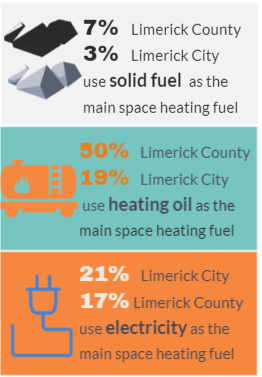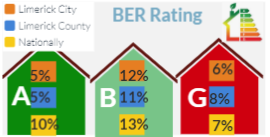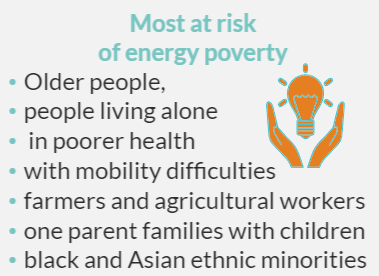2.19 Energy Efficiency / Renewables/Green
Renewable energy plays an important role in energy production nationally and in Limerick. In progressing climate action measures and in order to achieve 2030 targets for Ireland, energy from renewable sources is expected to grow significantly.
Energy from Renewables
Limerick has assets / resources to support the development of renewable energy sources.
In Limerick, 12 solar farms have been permitted with an output capacity of 113.49 MW and there are 15 wind farms with a total output of 205.75 MW.
There is significant potential to harness energy from the River Shannon, subject to an appropriate level of environmental and ecological assessment. The concept of the Atlantic Green Digital Basin (GDB) is being explored as a project to achieve a green and a digitally-diversified region. The GDB project aims to support a business cluster that uses digital technologies powered 100% by own-generated energy from renewables to create a centre point for Europe’s digital traffic and a global exporter of clean energy.

There is potential for development of community-based renewable energy projects. In recent years, community-supported renewable energy projects have had access to the energy market. For instance, Limerick is one of two EU ‘Lighthouse’ cities (Limerick and Trondheim Norway) selected for a climate-change pilot project focused on how to reduce the carbon footprint of urban areas. The EU +CityxChange Programme (Positive City Exchange) in Limerick is rolling out a project in the Georgian quarter of the city. This is a testbed for data collection and new technologies to transform it into a positive energy city centre where it creates more electricity than it uses.
Energy Efficiency of Buildings: Reliance on Fossil Fuels
Based on national and county-level data on dwellings that have completed Building Energy Rating (BER) audits, the trend has been towards the reduction in fossil fuels (oil, gas, solid fuel, LPG) as the main space heating source and improved energy efficiency of buildings. CSO data[1] on main sources of energy used in domestic and non-domestic buildings from 2010 to 2022, however, shows continued strong reliance on fossil fuels. Electricity is the main space heating source used (82%) in the most recently constructed dwellings (2020-2022) compared even to those constructed in 2015-2019 where 48% of dwellings w ith a BER audit used electricity.
ith a BER audit used electricity.
Age of dwellings is a key factor in terms of energy efficiency of buildings. In dwellings constructed in 2015-2019 and 2020-2022 with a BER rating, 96% and 99% respectively are given an “A” rating compared with 33% in 2010-2014 and 1% in 2005-2009.
Considering all dwellings in Limerick with BER audits (43,777), 21% in the City and 17% in the County use electricity as its main space heating fuel with the remainder using a fossil fuel source. There is a higher dependence on sources other than electricity in the more rurally-based county (83%) compared with the city (79%). Of the main space heating sources, a larger proportion of county dwellings use heating oil (50%) and solid fuel (7%) compared with those sources in the city (19% heating oil and 3% solid fuel). Mains gas is the most important source in the city (57%) compared with 25% of dwellings using this source in the county.
Building Energy Ratings (BERs): Limerick
If we examine BERs for Limerick City and Limerick County (2009-2022), based on 18,705 dwellings in the city and 25,223 in the county and an average age of dwelling of 38 years, only 5% in the city and 5% in the county have an A rating. This compares with a national average of 10% with an average age of dwelling of 33 years. Twelve percent (12%) in Limerick City and 11% in Limerick County have B ratings (B1 to B3) compared with 13% at national level. The most common rating is C with 40% of dwellings in the city and 38% in the county have ratings from C1 to C3. Six percent (6%) of dwellings in the City and 8% in the County have a G (worst) rating compared with 7% at national level.
More rural counties (M ayo, Leitrim, Roscommon, Tipperary) generally have worse ratings – with a smaller percentage rated A and B and a larger percentage with G ratings. Dublin and the urbanised counties around Dublin (with larger tracts of more-recently built accommodation) have the best ratings.
ayo, Leitrim, Roscommon, Tipperary) generally have worse ratings – with a smaller percentage rated A and B and a larger percentage with G ratings. Dublin and the urbanised counties around Dublin (with larger tracts of more-recently built accommodation) have the best ratings.
These data on energy use and energy efficiency of domestic and non-domestic buildings shows that there is great need and much scope to reduce dependence on fossil fuels and improve the energy efficiency of our buildings – across public bodies, businesses, community / sports and other user types as well as dwellings. A local Limerick study to audit community buildings and community cultural facilities across the city and county (2020-2021) found that these building mostly have poor energy efficiency and are strongly reliant on fossil fuels as the main source of heating.
Social Aspects of Energy Efficiency & Energy Poverty
 Analysis of social aspects of energy efficiency of dwellings (based on Census 2016 data) shows that older people, unemployed people, one-parent families with children, one person households, people with poor mobility and people from black and Asian ethnicity are more at risk of energy poverty. Dwellings that are occupied by people from these social backgrounds have lower combined A and B ratings, and in many cases, have the highest percentage of G ratings. Social groups living in dwellings with a higher percent of G ratings are farmers (9%), agricultural workers (11%), persons over 75 years (8%), people with mobility difficulties (7%), people living in very bad health (7%) and people living alone (7%).
Analysis of social aspects of energy efficiency of dwellings (based on Census 2016 data) shows that older people, unemployed people, one-parent families with children, one person households, people with poor mobility and people from black and Asian ethnicity are more at risk of energy poverty. Dwellings that are occupied by people from these social backgrounds have lower combined A and B ratings, and in many cases, have the highest percentage of G ratings. Social groups living in dwellings with a higher percent of G ratings are farmers (9%), agricultural workers (11%), persons over 75 years (8%), people with mobility difficulties (7%), people living in very bad health (7%) and people living alone (7%).
[1] Data from CSO. https://data.cso.ie/table/DBEREL01